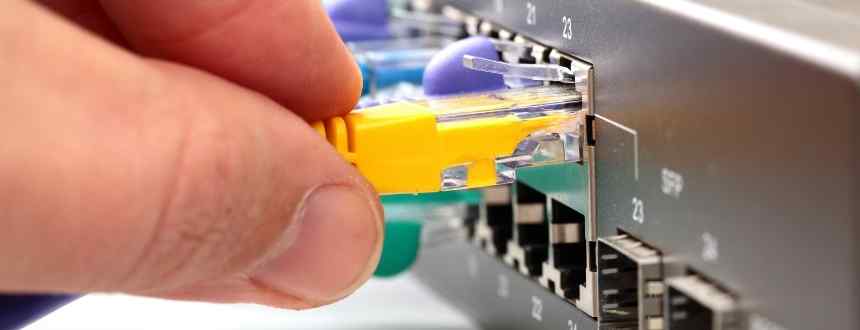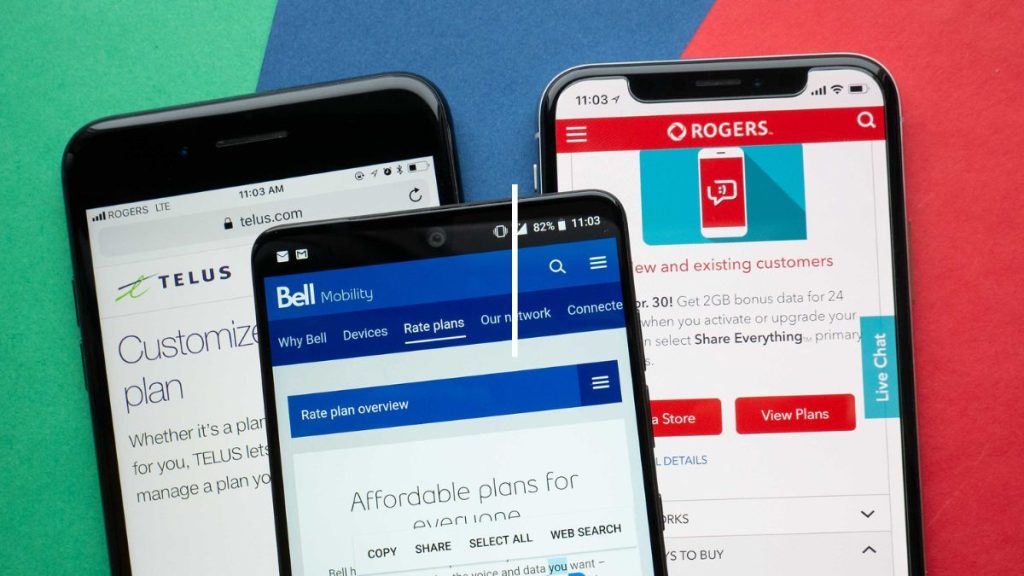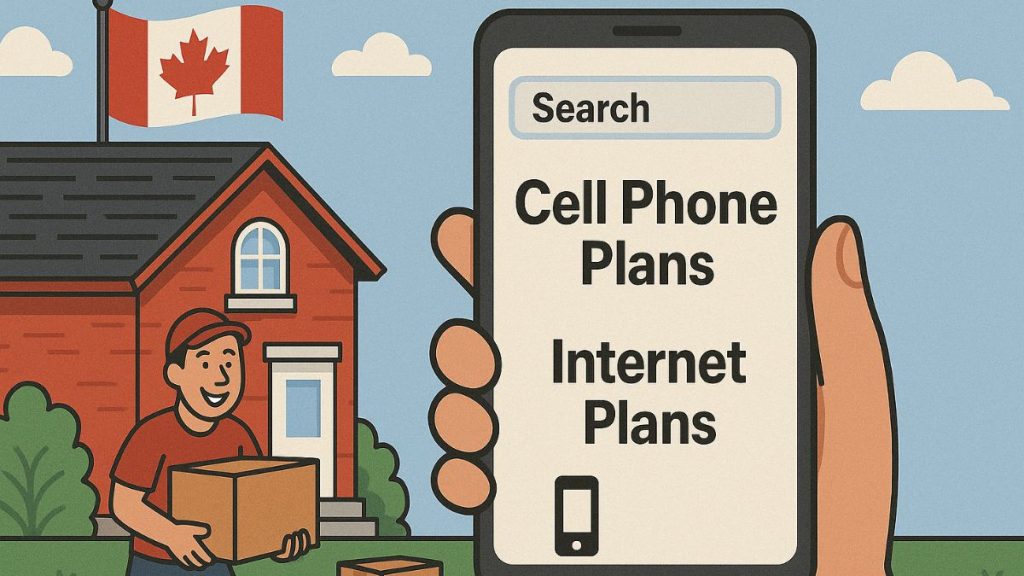Finding the right internet plan has never been a simple task. Canadians need to sort through dozens of plans from different providers, each at different price points with varying download speeds. On top of all this, consumers need to choose which kind of internet connection they want to end up purchasing. There are currently three central kinds of internet connections Canadians can purchase: DSL, cable and fibre optic. In this post, we’ll explain everything you need to know about these internet plans, introduce other alternatives, and help you find out which one is best for you. Let the DSL vs cable vs fibre internet debate begin!
Welcome to PlanHub, your mobile plan and internet subscription comparator.
DSL Internet
First up is Digital Subscriber Line or DSL internet. DSL’s main attraction is its ease of installation. To set up a DSL internet line, your provider will use the copper phone lines that run into your home to provide landline phone service. If you already have a home phone plan, setting up DSL internet will be a breeze. DSL internet is an attractive choice due to its accessibility. The majority of Canadians have access to home phone service, even in rural areas.
DSL internet doesn’t include the fastest speeds on the market, but it is highly affordable. Most DSL plans will offer speeds somewhere between 1Mbps and 100Mbps. In return, DSL prices are some of the lowest in the industry. Regardless of your provider or location, you should never have to end up paying more than $100 CAD for a DSL internet plan. Overall, you should consider a DSL plan if you don’t need insanely fast download speeds, and want internet service at a low price.
Cable Internet
While DSL uses the cable required for home phone service, cable internet uses the coaxial cable that delivers cable television to most homes. If you live somewhere that supports cable television, you should have no problem finding a cable internet plan. Cable is an attractive choice due to its accessibility and rapid speeds. Additionally, cable internet will never experience any outages or slow downs during stormy weather. It is possible for your cable connection to slow down a bit if your surrounding neighborhood is all connected to the internet via cable, but it should barely interfere with your daily usage.
Cable internet can operate at significantly faster speeds than DSL. When looking for a cable plan, you can expect to find plans with download speeds of hundreds of Mbps, and almost as much as 1Gbps. Of course, cable plans are also noticeably more expensive than DSL plans. Overall, cable internet is still one of the most affordable options, which offers tons of midrange plans. If you want an internet plan that’s not too expensive, and not the fastest or the slowest on the market, you might want cable internet. We’d recommend cable if you have a few devices that all connect to the internet and don’t want their performance to suffer.
Fibre Optic Internet
Finally, we’ll wrap up the DSL vs cable debate with the introduction of fibre internet. Fibre internet uses fibre optic glass cables to transfer information at a remarkably fast rate. Fibre is the newest kind of internet among these three, making it the least accessible of the bunch. There’s a chance that your installation may require additional work to equip your home with fibre technology. In addition, it’s almost exclusively available in more populous urban settings. Rural households seeking a fibre optic connection will struggle in finding one.
Fibre optic internet is the most expensive internet connection of the three. In exchange, it offers the highest download speeds by a significant margin. Fibre internet is the only internet connection capable of going as fast as 1Gbps, with some plans even surpassing this. The fastest fibre plans are capable of performing at 1.5Gbps! A fibre optic plan is probably perfect for you if you need the fastest internet speeds around. If you have a large household with loads of devices that use the internet, download large files frequently or need the best online gaming experience, you’ll benefit from a fibre optic internet plan.
Other Internet Types
DSL, cable and fibre optic are definitely the three most popular connection types right now. However, these aren’t the only kinds of internet connection on the market. Depending on your location, you might lack access to certain internet plans. On the other hand, the industry is constantly trying to introduce new internet technology to make our current plans look outdated. Keep reading to learn more about wireless and satellite internet.
Wireless Internet
Wireless internet distinguishes itself from other internet types. As the name implies, a wireless connection doesn’t require any external cable to connect your home to the internet. All you need is a router and you can get started! Wireless internet plans are attractive since they require no cables, can be set up easily, and will never experience latency during poor weather conditions.
Wireless internet is typically available in rural or remote areas where other internet plans are unavailable. It’s an attractive choice if you don’t live in an urban environment, but we wouldn’t recommend it if you can access other internet connection types. Wireless internet is both highly expensive and not very fast. Most wireless plans deliver speeds under 50Mbps, and can cost well over $100 CAD per month. Due to the cost of operating in remote locations, wireless plans are only truly “worth it” as a last resort. We’d recommend one if you don’t have much other choice and don’t mind having a slower internet plan for a hefty price.
Satellite Internet
New promising companies have started selling satellite internet plans to customers all over the globe. Companies like Starlink or Telesat in Canada use low-orbiting satellites. These satellites orbit the Earth while staying close enough to communicate with ground transceivers. When connected to a satellite internet plan, you can experience rapid internet speeds with incredibly low latency.
Satellite internet plans can currently reach speeds as high as 500 Mbps. However, as a relatively new technology, low Earth orbit satellite internet has potential to become the fastest kind of internet on the market. Satellite internet is currently expensive, since it’s new to the industry. Of course, it could also be risky to purchase a rising internet technology like this one. We’d recommend trying out satellite internet if you’re always trying to access the best of the best. If you’re hesitant about buying it right away, you could always wait around for a while. If it looks like it’s here to stay, go ahead and try it out for yourself!
DSL vs Cable vs Fibre & Others – Which to Choose?
At last, you know everything there is to know about the industry’s leading internet connections. At this point, you should have a better idea of which kind of internet is better suited for you. Do you need the high speeds of fibre optic internet? Or is a slower, more affordable DSL plan more up your alley? Of course, we can’t make this decision for you. The DSL vs cable vs fibre debate has no true winner – that’s the beauty of it! All we can do is present as much information as possible to you, until you feel ready to choose a single option. To make things simpler, check out our table recapping the five different internet types below:
| Type | Speed |
|---|---|
| DSL | 1-300Mbps |
| Cable | 300-750Mbps |
| Fibre | 500Mbps-1Gbps+ |
| Wireless | 1-100Mbps |
| Satellite | 1-500Mbps |
| Type | Pros |
|---|---|
| DSL | -Most affordable option, accessible to anyone that has home phone service |
| Cable | -Good midrange option → not too slow nor too expensive |
| Fibre | -Fastest option on the market |
| Wireless | -Can reach rural and remote locations across Canada |
| Satellite | -Provides incredibly low latency → has potential to provide speeds faster than fibre |
| Type | Cons |
|---|---|
| DSL | Download speeds aren’t nearly as high as its competitors |
| Cable | With fibre plans becoming cheaper, it’s hard to justify a cable plan |
| Fibre | Not accessible everywhere |
| Wireless | Very expensive rates for low download speeds |
| Satellite | Relatively new technology → expensive and somewhat risky |
DSL vs Cable vs Fibre – Conclusion
As a brand new expert of all things internet, you should now feel more than ready to choose your next internet plan. As long and tedious as the process may feel, finding the right connection type is a very important first step. After choosing an internet method that seems right for you, you end up narrowing down the options considerably. All that’s left to do is choose a single plan that speaks to you.
Naturally, this is easier said than done. However, we at PlanHub can help make this process much simpler than ever before.
This small green button will redirect you to our internet plan matching service. Here, you’ll be able to find your next internet plan in just a few short minutes. All you need to do is answer a few basic questions about your preferences. This way, we can understand what kind of internet plan you want. Finally, we’ll present you with a list of affordable internet plans that match your taste. The only thing left to do is choose one that seems appealing, get it set up, and enjoy your new internet plan!










